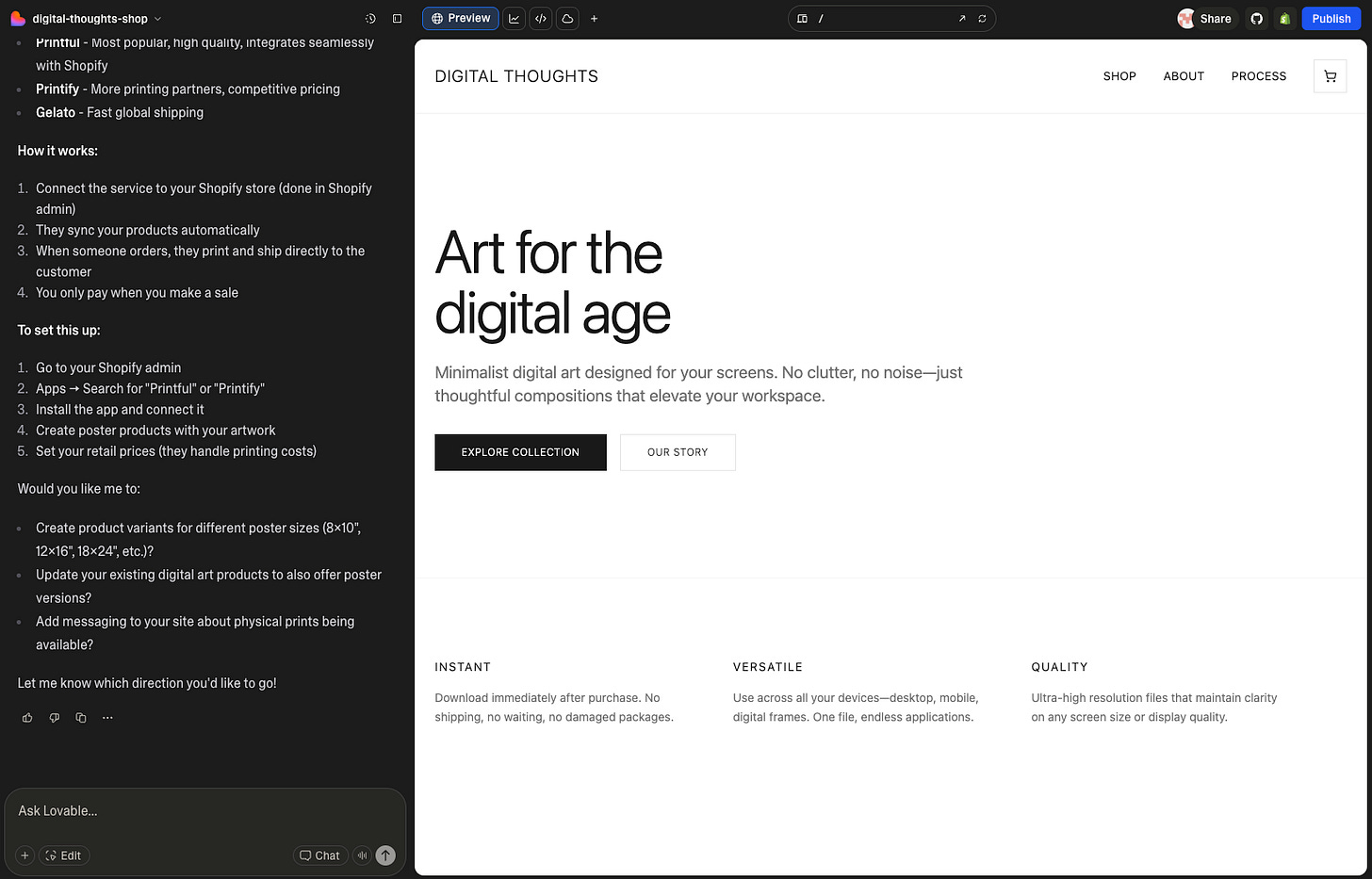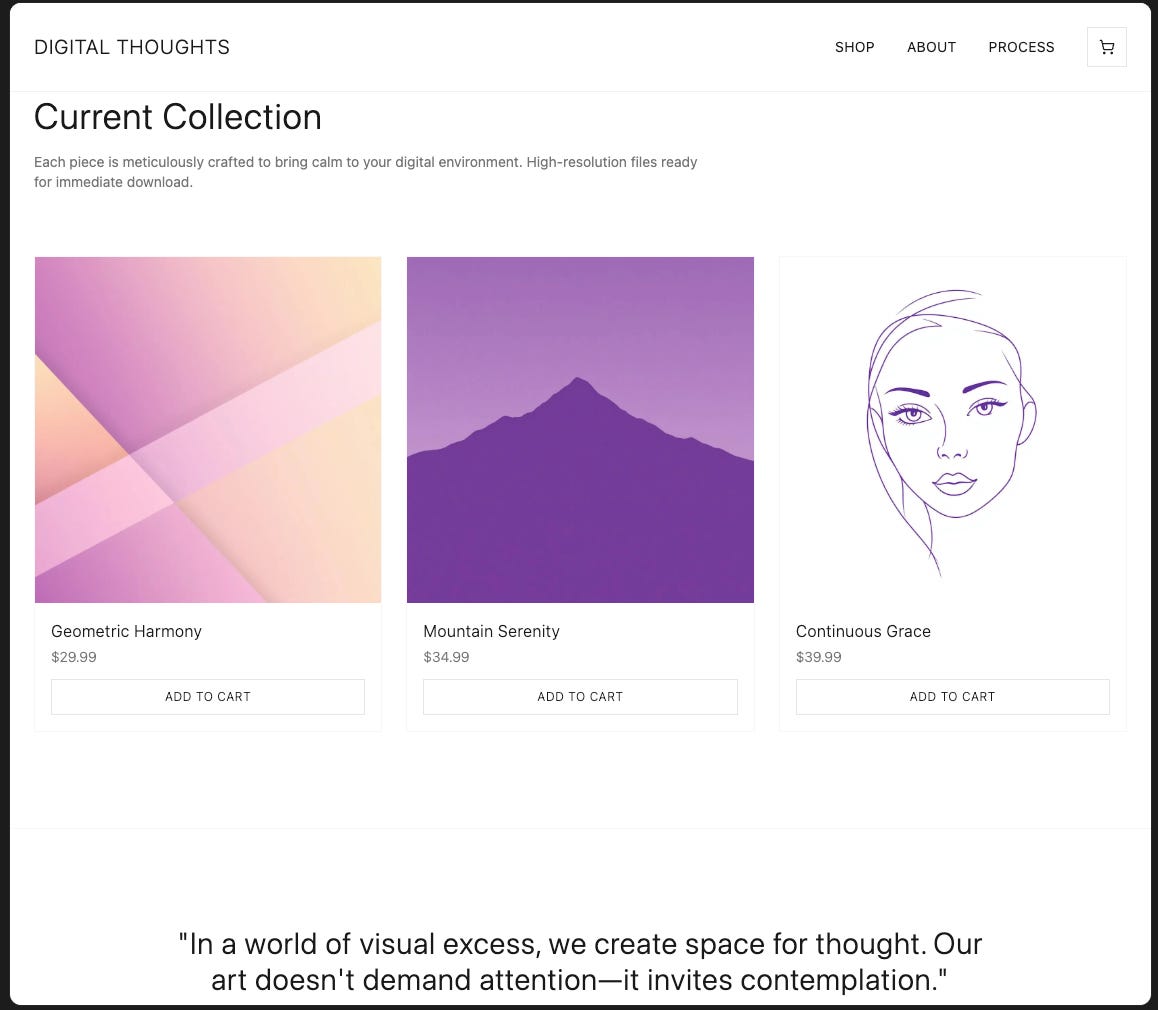Lovable x Shopify experiment in 3 prompts
(And It Actually Worked... Mostly)
Hey digital adventurers! So I did something last week that honestly surprised me. I took Lovable’s new Shopify integration for a spin and... well, I built an entire e-commerce store using exactly three prompts. THREE. And before you ask... yes, it was a real Shopify store with actual products and proper checkout functionality. Not a mock-up. Not a landing page. An actual store.
But here’s the thing nobody talks about with these AI builder tools... they’re simultaneously amazing AND frustratingly limited. And after spending time with Lovable’s Shopify integration, I’ve got thoughts. Lots of thoughts.
Let me walk you through what actually happened when a non-coding, semi-skeptical e-commerce person (that’s me) tried to build a digital art store from scratch using nothing but natural language prompts.
The Experiment: From Zero to Store in Minutes
Okay so first some context. Lovable just launched this Shopify integration in October 2025, and the promise sounded... kind of wild? You type what you want, and it generates a complete Shopify store with products, branding, checkout, everything. As someone who’s spent literally hundreds of hours setting up Shopify stores the traditional way, I was deeply skeptical.
But you know me... I had to try it. Because if this actually works, it changes the game for rapid store validation and testing. And if it doesn’t work, well, that’s valuable data too.
My first prompt was deliberately simple. I wanted to see what Lovable could do with minimal input:
“Create a Shopify store to sell digital art in form of files (so product images has to be low quality or watermarked). Store should be named: ‘Digital Thoughts Store’.”
And then... I waited. Would it understand what I meant? Would it create something usable? Or would it spit out a generic template that needed hours of manual cleanup?
Here’s what happened: Lovable actually BUILT a proper Shopify store. Like a real one. With a homepage, navigation, product structure, checkout flow, cart functionality. Everything you’d expect from a basic e-commerce site.
I was genuinely impressed. This wasn’t just generating HTML or creating a mock design. It was actually creating the frontend AND connecting it to Shopify’s backend. The store existed. It worked.
Going Deeper: Adding Products and Branding
My second prompt tested whether Lovable could handle specific product creation:
“Add three digital products to the store.”
And it did. It generated three digital art products with placeholder images (properly watermarked as I’d requested), descriptions, pricing structure, everything. The products appeared in the store, you could add them to cart, the checkout flow worked correctly.
This is where things got interesting. Because yes, you CAN do similar things in Shopify’s backend through their theme customizer. But the speed here was different. Instead of clicking through menus, configuring settings, manually uploading product images, writing descriptions... Lovable just generated everything based on my prompt.
My third prompt pushed further:
“Add some branding – colours, pages, etc.”
And Lovable adjusted the visual design, created additional pages (About, Contact, whatever standard e-commerce pages you’d expect), applied a cohesive color scheme. The store started looking less like a template and more like something intentional.
The whole process... maybe 10 minutes? From blank slate to functional store with products and branding.
If you’ve ever set up a Shopify store from scratch, you know this normally takes HOURS. Even with Shopify’s excellent backend and theme system, there’s just a lot of configuration involved. Product uploads, page creation, navigation setup, payment configuration, shipping settings... it adds up.
Lovable compressed that timeline dramatically.
The Reality Check: Where It Actually Shines
Let’s be honest about what Lovable is doing here. It’s not magic. It’s generating a custom frontend theme and connecting it to Shopify’s proven backend infrastructure. The integration pairs Shopify’s commerce foundation – reliable checkout, payments, subscriptions, taxes, and app ecosystem – with Lovable’s AI-powered builder.
But here’s what makes it valuable...
Speed of Validation: If you want to test a store concept quickly, this is genuinely game-changing. You can go from idea to functional store in minutes instead of days. For founders validating product ideas or creators testing new offerings, that speed matters.
Lower Barrier to Entry: The technical setup has traditionally been the biggest barrier to entry in e-commerce. The Lovable and Shopify integration basically vaporizes that barrier. You don’t need to understand theme customization or navigation structure or page hierarchy. You just describe what you want.
Iteration Freedom: Because setup is so fast, you can experiment freely. Want to test different branding approaches? Different product layouts? Different store structures? Just regenerate with new prompts. The cost of experimentation drops to near zero.
This connects to something I wrote about when discussing vibe coding and how AI democratizes development. We’re moving toward a world where “I want to build X” becomes “I built X” with minimal friction in between.
The Limitations: Where Human Touch Still Matters
But okay... let’s talk about where Lovable hits its limits. Because it does have limits. Clear ones.
When I asked Lovable to modify my digital art products into physical posters, it couldn’t execute that change. It gave me INSTRUCTIONS on what to do in Shopify’s backend. But it couldn’t actually make the modification itself.
The Lovable + Shopify integration is designed for building and launching new Shopify stores only. Existing stores cannot be connected or managed through this integration.
This is crucial to understand. Lovable excels at INITIAL CREATION. It’s brilliant at going from zero to one. But once you need detailed customization, specific backend configuration, or modifications that require Shopify admin access... you’re on your own.
Think about it like this: Lovable gives you an incredibly solid foundation. But if you’re serious about selling, you still need to do the heavy lifting:
Detailed product configuration (variants, SKUs, inventory tracking)
Payment gateway setup and KYC verification
Shipping rules and tax configuration
App integrations for marketing, analytics, inventory
SEO optimization and meta tags
Advanced customization of checkout flow
Email templates and customer communication
All of that still requires manual work in Shopify’s backend. Lovable creates the storefront. YOU create the business.
And honestly? That’s probably appropriate. Because those details SHOULD require human judgment and strategic decisions. The danger with full automation would be creating stores that technically function but strategically fail.
What This Really Means for E-commerce
After spending time with this integration, I keep thinking about my AI-orchestrated e-commerce experiment and where tools like Lovable fit into that vision.
The value isn’t in replacing the entire setup process. It’s in dramatically accelerating the CREATION phase so you can focus on the STRATEGY phase.
Traditionally, entrepreneurs spend weeks or months just getting a store launched. By the time they’re finally ready to test their product-market fit, they’re already exhausted and out of money. Many never make it past the setup phase.
Lovable’s Shopify integration is designed for creators turning audience demand into products, founders validating new ideas with real checkout and fast iterations, and existing Shopify brands adding new surfaces.
This changes that dynamic. You can validate your concept with a real, functioning store in hours instead of weeks. You learn what works BEFORE investing significant resources into customization and optimization.
It’s similar to what I discovered when building apps with AI. The tools don’t replace expertise. They accelerate iteration cycles. You test more ideas in less time, learn faster, fail cheaper.
For existing e-commerce operators, the use case is different but equally valuable. Want to test a new product vertical without disrupting your main store? Spin up a micro-store with Lovable in minutes. Running a limited-edition drop? Create a dedicated storefront specifically for that campaign. Testing different positioning for the same products? Generate multiple versions and A/B test.
The speed unlocks experimentation that wasn’t economically viable before.
The Technical Reality: What’s Actually Happening
Let me geek out for a second about what Lovable is technically doing, because understanding this helps set appropriate expectations.
Lovable creates what Shopify calls a “headless” storefront. The frontend (what customers see) is custom-generated by Lovable’s AI. The backend (cart, checkout, payments, inventory) is Shopify’s standard infrastructure.
This architecture has real advantages:
Design Freedom: You’re not limited to Shopify’s theme marketplace. Lovable generates completely custom frontend code based on your requirements.
Modern Stack: The generated storefronts use current web technologies rather than being constrained by Shopify’s Liquid templating.
Flexibility: Because the frontend is separate from the backend, you can theoretically customize it extensively if you have development skills.
But it also has implications:
App Compatibility: Some Shopify apps expect to work with Liquid themes. Headless setups can have integration challenges with certain apps.
Ongoing Maintenance: Custom code requires ongoing maintenance. If Shopify updates their APIs, your custom frontend might need updates too.
Handoff Limitations: Once you “claim” your store in Shopify, you own the code. But making significant changes requires understanding the generated codebase.
This is similar to what I discussed in my comparison of vibe coding platforms. The AI generates functional code quickly, but long-term success requires understanding what was generated and being prepared to maintain it.
My Honest Assessment: When Does This Actually Make Sense?
After this experiment, here’s my framework for when Lovable’s Shopify integration is genuinely valuable versus when traditional setup makes more sense:
Use Lovable When:
You’re validating a new store concept and need speed over perfection
You’re testing product ideas before committing to full inventory
You’re creating temporary or campaign-specific storefronts
You’re a creator/founder without technical background testing e-commerce
You want to experiment with multiple store concepts simultaneously
Time to market matters more than extensive customization
Use Traditional Setup When:
You’re launching a long-term business with complex requirements
You need extensive app integrations from day one
Your products require complicated variant/inventory logic
You’re migrating from another platform with existing customer data
You need advanced customization that goes beyond Lovable’s capabilities
You have specific technical requirements for your industry
The key distinction: Lovable optimizes for SPEED. Traditional setup optimizes for CONTROL.
Both approaches are valid depending on your situation and goals.
The Broader Pattern: AI-Accelerated Workflows
What fascinates me about tools like Lovable isn’t just the e-commerce application. It’s the broader pattern we’re seeing across AI integration and business automation.
AI is getting really good at taking structured domains (like e-commerce store setup) and compressing the execution timeline. Not by replacing human decision-making, but by handling the mechanical steps that don’t require strategic judgment.
When I wrote about product owners becoming their own technical co-founders, this is exactly what I meant. The barriers between “I have an idea” and “I’ve built something testable” are collapsing.
Lovable’s Shopify integration is just one example. But the pattern repeats across:
Claude with MCP for accessing real-world data
Cursor and GitHub Copilot for accelerated development
Make.com and Zapier for business automation
Various AI builders for landing pages, apps, and tools
The common thread: Traditional setup requires hours or days of design, configuration, and integrations. With AI builders, you can now do this in minutes.
What I’m Watching For: The Evolution
This integration just launched in October 2025, so it’s early days. Here’s what I’m curious to see evolve:
Better Backend Integration: Right now, Lovable handles frontend creation brilliantly but hands off to manual Shopify admin work for backend configuration. I’d love to see deeper integration where Lovable can help with payment setup, shipping rules, tax configuration through conversation.
Existing Store Support: Currently only for new stores, but the ability to enhance or modify existing stores through AI conversation would be incredibly valuable.
Multi-Store Management: For entrepreneurs running multiple storefronts, a unified way to manage and iterate across stores through Lovable would be powerful.
Post-Launch Optimization: Once stores are live, using AI to analyze performance and suggest improvements based on actual customer behavior.
Custom App Integration: Better support for the Shopify app ecosystem within the Lovable creation flow.
The technology is moving fast. What feels limiting today might be standard functionality six months from now.
The Real Question: Should YOU Try This?
If you’re considering testing Lovable’s Shopify integration, here’s my honest advice:
Definitely Try It If:
You’ve been wanting to launch an e-commerce store but felt overwhelmed by setup
You’re testing multiple product ideas and need speed over perfection
You’re comfortable with iteration and okay with some manual backend work
You want to learn what AI-powered development feels like firsthand
You have a tight timeline for getting something live
Maybe Wait If:
You need extensive customization and complex business logic from day one
You’re not comfortable with any manual Shopify admin work
You require specific app integrations that might not work with headless setups
You’re building something long-term that requires extensive ongoing maintenance
You prefer full control over every aspect of your store from the start
The 30-day free Shopify trial through Lovable significantly reduces the risk of experimentation. You can build and test without financial commitment, then decide if the approach works for your needs.
Remember: tools like this aren’t about replacing expertise. They’re about accelerating the path from concept to validation. You still need to understand your market, know your customers, make strategic decisions. Lovable just makes the tactical execution faster.
My Final Thoughts: The Time-Saving Sweet Spot
After this experiment, I keep coming back to one insight: Lovable’s Shopify integration is EXACTLY what I talked about regarding when automation makes sense.
It automates the repetitive, mechanical aspects of store creation (theme setup, page structure, basic product configuration) while preserving human control over strategic decisions (what to sell, how to position it, what customization matters).
For my “Digital Thoughts Store” experiment, the three-prompt process took maybe 10 minutes total. Setting up the same store traditionally would have taken 2-3 hours minimum. That’s an 18x time savings on initial creation.
But then I still needed to configure Shopify settings, set up payment processing, optimize product details, configure shipping. That took another hour. So the total savings was more like 50% rather than 90%.
That’s still MASSIVE for rapid validation and testing. But it’s important to have realistic expectations about what gets automated versus what requires manual work.
The future I’m excited about? Tools like Lovable continuing to improve while AI systems become better at autonomous operations. We’re moving toward a world where building and operating digital businesses becomes dramatically more accessible.
We’re not there yet. But experiments like this Shopify integration show we’re heading in that direction fast.
PS. How do you rate today’s email? Leave a comment or “❤️” if you liked the article - I always value your comments and insights, and it also gives me a better position in the Substack network.




